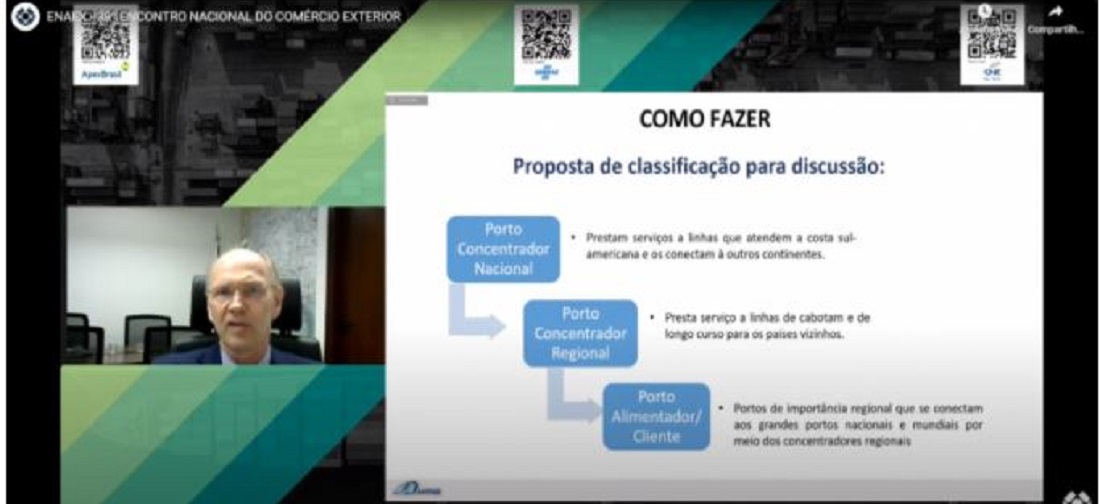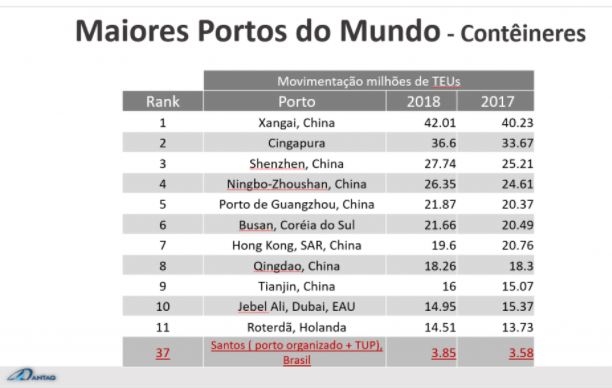
ANTAQ director emphasises need to adapt container ports to receive larger vessels
Nov, 16, 2020 Posted by Ruth HollardWeek 202047
On November 13, Adalberto Tokarski, Director of ANTAQ (the national waterway transport agency) spoke on the “International Transport and Logistics in Brazil” panel of the 39th National Foreign Trade Meeting – ENAEX. The meeting, sponsored by AEB (the Brazilian foreign trade association), is considered the largest thematic forum for debates in the sector in Brazil and brings together businesses, government, and export & logistics representatives. This year, the event was attended by the Minister of Economy, Paulo Guedes.
In his speech, Tokarski highlighted the phenomenon of containerization and the strategy for classifying public ports, including adapting ports to have large drafts to receive bigger and bigger vessels. “It is a question of competitiveness, of economies of scale. But in order to receive these ships, Brazilian ports must invest in the deepest and widest access channels, the most extensive quays and yards, equipment with greater handling capacity, road and rail access, and technology, which requires large investments”, he pointed out.
According to the Director of ANTAQ, due to the high infrastructure costs, it will be necessary to rethink the model and prioritize investments in these public ports to increase the capacity of national container terminals. Tokarski added that currently, only around five Brazilian terminals are able to receive ships of 12 thousand TEU.
“Will they be able to start receiving ships of a 14,000-TEU capacity? Anyway, this is a gradual process, which must be thought out with a lot of criteria and priority, if we really want to enter the global fight of container handling efficiently”, he observed, adding that in terms of productivity, Brazilian container terminals should be nothing but the best in the world.
He explained that these hub ports should be classified into three types: national hub; regional concentrating port; and feeder/customer port. The first will provide services to lines that serve the South American coast and connect them to other continents; the second type will provide services to cabotage and long-distance lines to neighboring countries; and the third type will be integrated by ports of regional importance that will connect to major national and world ports, through regional hub ports. Tokarski said the country could have five to six national hub ports along its coast.
Referring to the increase in the movement of grains in Brazilian ports, Tokarski highlighted the growth in the supply of port infrastructure for the flow of grain production through the so-called Arco Norte: “How good that we have a more structured exit from the north, both by the Tapajós, Miritituba, and Itaituba River, and by the Madeira River, in Porto Velho, and that the ports of Pará are better prepared to receive these loads”.
Tokarski informed that the Agency is conducting a study to find out if the private contribution in the transportation and cargo handling infrastructure in the region is sufficient to guarantee the flow of grain production, which grows by 5% every year, and if the federal government needs to make more public port areas available for private users to deploy new terminals.
-
Ports and Terminals
Mar, 20, 2024
0
Emap and Transpetro sign partnership to decarbonize operations at the Port of Itaqui
-
Ports and Terminals
Jun, 02, 2023
0
Port of Santos braces for impact as tax auditors consider indefinite strike
-
Grains
Jul, 25, 2024
0
Rice exports in Brazil benefit from heated international demand
-
Shipper/Freight Forwarders Rankings – commodity wise
Jan, 19, 2022
0
CMA CGM revamps online spot pricing system



